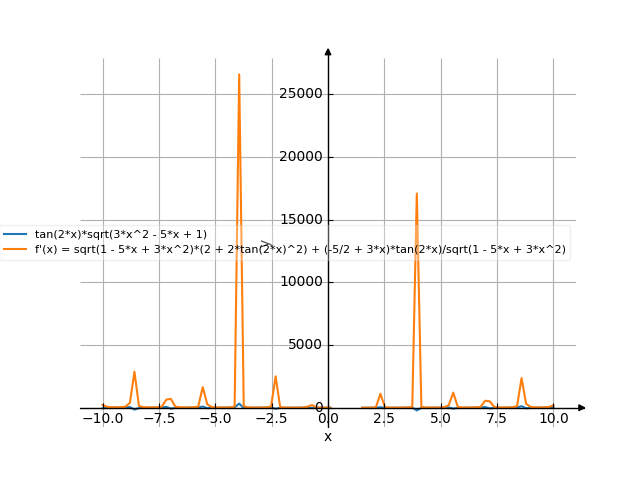Derivative of (tg2x)*sqrt(3x^2-5x+1)
The solution
________________
/ 2
tan(2*x)*\/ 3*x - 5*x + 1
/ ________________\ d | / 2 | --\tan(2*x)*\/ 3*x - 5*x + 1 / dx
-
Apply the product rule:
; to find :
-
Rewrite the function to be differentiated:
-
Apply the quotient rule, which is:
and .
To find :
-
Let .
-
The derivative of sine is cosine:
-
Then, apply the chain rule. Multiply by :
-
The derivative of a constant times a function is the constant times the derivative of the function.
-
Apply the power rule: goes to
So, the result is:
-
The result of the chain rule is:
-
To find :
-
Let .
-
The derivative of cosine is negative sine:
-
Then, apply the chain rule. Multiply by :
-
The derivative of a constant times a function is the constant times the derivative of the function.
-
Apply the power rule: goes to
So, the result is:
-
The result of the chain rule is:
-
Now plug in to the quotient rule:
-
; to find :
-
Let .
-
Apply the power rule: goes to
-
Then, apply the chain rule. Multiply by :
-
Differentiate term by term:
-
The derivative of a constant times a function is the constant times the derivative of the function.
-
Apply the power rule: goes to
So, the result is:
-
-
The derivative of a constant times a function is the constant times the derivative of the function.
-
The derivative of a constant times a function is the constant times the derivative of the function.
-
Apply the power rule: goes to
So, the result is:
-
So, the result is:
-
-
The derivative of the constant is zero.
The result is:
-
The result of the chain rule is:
-
The result is:
-
-
Now simplify:
The answer is:
________________
/ 2 / 2 \ (-5/2 + 3*x)*tan(2*x)
\/ 3*x - 5*x + 1 *\2 + 2*tan (2*x)/ + ---------------------
________________
/ 2
\/ 3*x - 5*x + 1
/ 2 \
| (-5 + 6*x) |
|-12 + --------------|*tan(2*x)
/ 2 \ ________________ | 2|
2*\1 + tan (2*x)/*(-5 + 6*x) / 2 / 2 \ \ 1 - 5*x + 3*x /
---------------------------- + 8*\/ 1 - 5*x + 3*x *\1 + tan (2*x)/*tan(2*x) - -------------------------------
________________ ________________
/ 2 / 2
\/ 1 - 5*x + 3*x 4*\/ 1 - 5*x + 3*x
/ 2 \ / 2 \
/ 2 \ | (-5 + 6*x) | | (-5 + 6*x) |
3*\1 + tan (2*x)/*|-12 + --------------| 3*|-12 + --------------|*(-5 + 6*x)*tan(2*x)
________________ | 2| / 2 \ | 2|
/ 2 / 2 \ / 2 \ \ 1 - 5*x + 3*x / 12*\1 + tan (2*x)/*(-5 + 6*x)*tan(2*x) \ 1 - 5*x + 3*x /
16*\/ 1 - 5*x + 3*x *\1 + tan (2*x)/*\1 + 3*tan (2*x)/ - ---------------------------------------- + -------------------------------------- + --------------------------------------------
________________ ________________ 3/2
/ 2 / 2 / 2\
2*\/ 1 - 5*x + 3*x \/ 1 - 5*x + 3*x 8*\1 - 5*x + 3*x /


![Find the derivative of y' = f'(x) = (tg2x)*sqrt(3x²-5x+1) ((tg2x) multiply by square root of (3x squared minus 5x plus 1)) - functions. Find the derivative of the function at the point. [THERE'S THE ANSWER!] (tg2x)*sqrt(3x^2-5x+1)](/media/krcore-image-pods/176/hash/derivative/3/be/8f201039d2dbdea4ca7db3a8409aa.png)
 Derivative of 8
Derivative of 8
 Derivative of y=2x
Derivative of y=2x
 Derivative of 5^(2*x)
Derivative of 5^(2*x)
 Derivative of x^(3/2)-3*x+1
Derivative of x^(3/2)-3*x+1